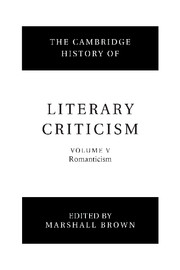Book contents
- Frontmatter
- Introduction
- 1 Classical standards in the period
- 2 Innovation and modernity
- 3 The French Revolution
- 4 Transcendental philosophy and Romantic criticism
- 5 Nature
- 6 Scientific models
- 7 Religion and literature
- 8 Language theory and the art of understanding
- 9 The transformation of rhetoric
- 10 Romantic irony
- 11 Theories of genre
- 12 Theory of the novel
- 13 The impact of Shakespeare
- 14 The vocation of criticism and the crisis of the republic of letters
- 15 Women, gender and literary criticism
- 16 Literary history and historicism
- 17 Literature and the other arts
- Bibliography
- Index
- References
5 - Nature
Published online by Cambridge University Press: 28 March 2008
- Frontmatter
- Introduction
- 1 Classical standards in the period
- 2 Innovation and modernity
- 3 The French Revolution
- 4 Transcendental philosophy and Romantic criticism
- 5 Nature
- 6 Scientific models
- 7 Religion and literature
- 8 Language theory and the art of understanding
- 9 The transformation of rhetoric
- 10 Romantic irony
- 11 Theories of genre
- 12 Theory of the novel
- 13 The impact of Shakespeare
- 14 The vocation of criticism and the crisis of the republic of letters
- 15 Women, gender and literary criticism
- 16 Literary history and historicism
- 17 Literature and the other arts
- Bibliography
- Index
- References
Summary
Of all ideas commonly associated with Romanticism in the arts, the idea of nature is perhaps the most inclusive and the most evocative. The only rival for this role would be the concept of creativity of the human mind and the power of the poetic imagination. Both ideas are closely interrelated. Romantic ‘nature’ is essentially a space of the imagination, which in turn draws from her most of its imagery. Romantic literature and painting abound in representations of pristine landscapes and scenes of blissful simplicity, of genuinely perceived particular phenomena of the natural world and bold visions of its overall harmony with the world of man. To be sure, there are also the experience of solitude and the adventure or despair of the wilderness, awesome and frightful sceneries symbolizing the abandonment of a soul adrift from the moorings of the familiar world. During the Romantic period, nature in its physical appearance emerged as the privileged material for expressing a human subject emancipated from the traditional restrictions of religion and society and experiencing the unfathomable depth of the soul. Confronted with a self-imposed freedom and the loss of sense of a ‘natural’ belonging, this subject developed, together with a rich and infinitely differentiated emotionality, an equally infinite longing for a lost unity and harmony resonantly evoked as ‘nature’.
Indeed, one way of defining the Romantic movement in Europe between 1770 and 1830 and accounting for its unity and specificity across the varieties and differences of individuals, media, genres, chronologies and, last but not least, national traditions, is to regard it as an aesthetic reaction to, and compensation for, the thrust of an onrushing modernity.
- Type
- Chapter
- Information
- The Cambridge History of Literary Criticism , pp. 92 - 114Publisher: Cambridge University PressPrint publication year: 2000
References
- 3
- Cited by



